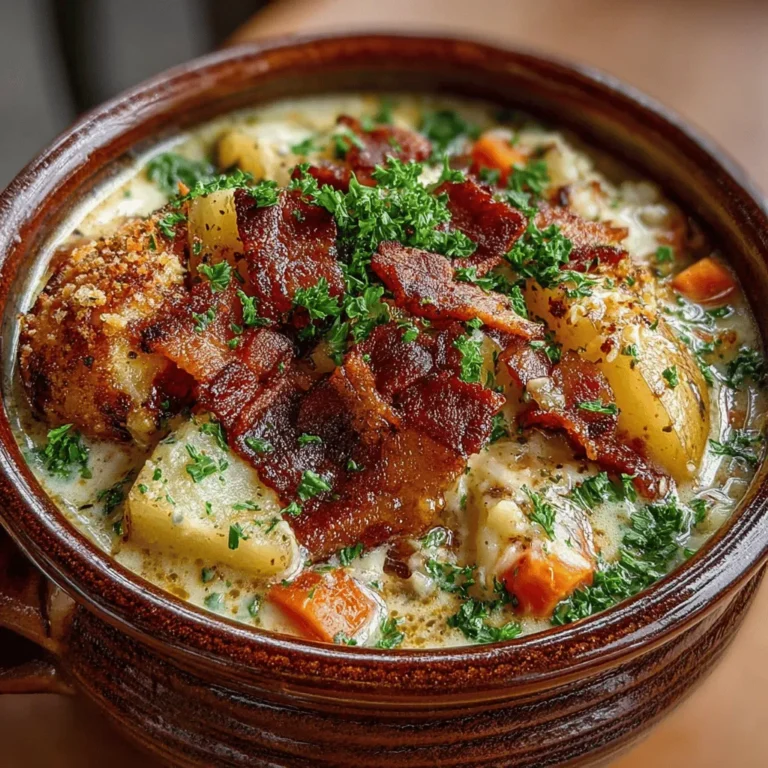Introduction to New England Comfort in a Bowl
In the heart of New England, where the Atlantic coastline is dotted with quaint fishing villages and bustling ports, a rich culinary tradition thrives—especially when it comes to seafood. The region is celebrated for its bounty from the sea, and few dishes encapsulate this heritage quite like clam chowder. However, in this article, we take a fresh approach to this beloved classic, presenting it as “New England Comfort in a Bowl.” This dish is a harmonious blend of the briny essence of clams, the smoky flavor of bacon, creamy textures, and a medley of fresh vegetables. More than just a meal, it offers an experience that warms the soul and evokes the cozy ambiance of a New England kitchen on a chilly day.
This recipe, while rooted in tradition, allows for personal touches and adaptations, making it a versatile dish that can be enjoyed year-round. As we explore the ingredients, preparation methods, and the comforting history behind this iconic chowder, you’ll discover why it holds a special place in the hearts—and stomachs—of many.
The Essence of New England Clam Chowder
Historical Context of Clam Chowder
Clam chowder has a storied past that dates back to the early 18th century, with its origins often traced back to the coastal regions of New England. The dish likely emerged from a blend of Native American cooking and the culinary practices of European settlers who arrived in the New World. The indigenous tribes had long utilized clams as a staple food source, while settlers began to adapt their recipes, incorporating local ingredients and flavors.
The evolution of clam chowder has given rise to several regional variations, with two primary styles dominating the conversation: Manhattan and New England chowders. Manhattan clam chowder is tomato-based and often features a different array of vegetables, while New England clam chowder is characterized by its creamy base and rich flavors, making it a true comfort food staple. This creamy variant not only highlights the fresh clams but also reflects the agricultural abundance of the region, incorporating ingredients such as potatoes, onions, and celery.
The significance of clam chowder in local culture cannot be overstated. It’s a dish often served at family gatherings, community events, and holiday celebrations, symbolizing warmth and hospitality. For many, it brings back memories of seaside vacations, family dinners, and the simple joys of life.
Understanding the Ingredients
To create an outstanding bowl of New England Comfort in a Bowl, it’s essential to understand the key ingredients that contribute to its signature flavor and texture.
1. Fresh Clams: The star of the dish, clams provide a briny, ocean-fresh taste that is irreplaceable. Using high-quality, fresh clams is crucial, as they not only enhance the flavor but also contribute to the overall authenticity of the chowder. Varieties such as quahogs or cherrystones are commonly used, with their tender meat adding a delightful chewiness to each spoonful.
2. Bacon: The inclusion of bacon elevates the dish by infusing it with a smoky richness that beautifully complements the clams. Cooking the bacon to achieve the perfect level of crispiness ensures that it provides not just flavor but also a satisfying texture contrast.
3. Potatoes: Essential for both texture and nourishment, potatoes serve as a hearty base that absorbs the flavors of the chowder while adding a creamy consistency when cooked down. Varieties such as Yukon Gold or Russet are ideal choices due to their starchy qualities.
4. Vegetables: A medley of vegetables, including onions, carrots, and celery, form the aromatic backbone of the chowder. These ingredients are sautéed to release their natural sweetness, deepening the flavor profile of the dish.
5. Seasonings: The addition of garlic, bay leaves, and thyme provides aromatic depth that rounds out the dish, creating a symphony of flavors that dance on the palate.
Step-by-Step Guide to Making New England Comfort in a Bowl
Preparing the Base Flavors
Creating the perfect New England Comfort in a Bowl begins with preparing the foundational flavors that will set the stage for this rich and satisfying chowder.
1. Cooking the Bacon: Begin by rendering the bacon in a large, heavy-bottomed pot over medium heat. Allow the bacon to cook slowly, stirring occasionally, until it achieves a deep golden brown and crispy texture. This process not only cooks the bacon but also releases its flavorful fat, which will serve as the base for the chowder. Once cooked, remove the bacon from the pot and set it aside, leaving the rendered fat to infuse the chowder with its smoky essence.
2. Sautéing the Vegetables: With the bacon fat still in the pot, add diced onions, carrots, and celery—often referred to as the mirepoix. Sauté these vegetables over medium heat until they become tender and translucent, typically around 5 to 7 minutes. This step is crucial for building depth in flavor, as it allows the natural sweetness of the vegetables to develop and meld with the savory notes of the bacon fat.
3. Aromatics for Added Depth: To further enhance the chowder’s flavor, add minced garlic and a bay leaf to the sautéed vegetables. The garlic should be added just a minute or so before you proceed to the next steps, allowing it to release its aromatic oils without burning. The bay leaf will impart a subtle earthiness, enriching the overall flavor profile of the chowder.
As you prepare the base flavors, the kitchen will begin to fill with enticing aromas, hinting at the comforting bowl of chowder that is soon to come. The combination of fresh ingredients and careful preparation lays the groundwork for a dish that is not only delicious but also deeply rooted in the culinary heritage of New England.
Stay tuned as we continue our journey into making New England Comfort in a Bowl, where we will explore the next steps and reveal how to bring this iconic dish to life.
{{image_2}}
Creating the Chowder
Incorporating Diced Potatoes
When it comes to making a classic New England clam chowder, the choice of potatoes is crucial for achieving the perfect texture. Ideal varieties include Yukon Gold and Russet potatoes. Yukon Golds lend a creamy texture and buttery flavor, while Russets help to thicken the chowder due to their higher starch content.
Preparation Tips:
– Begin by peeling and dicing the potatoes into uniform cubes, approximately 1/2-inch in size. This ensures even cooking and prevents any pieces from turning mushy before the chowder is ready.
– Soak the diced potatoes in cold water for about 15 minutes to remove excess starch, which can make the chowder too thick. Drain and rinse them before adding to your chowder pot.
Using Clam Juice or Seafood Stock
A flavorful base is essential for any chowder. Using clam juice or a quality seafood stock enhances the depth of flavor. Clam juice can be found in most grocery stores, often sold in small cans or bottles. If you prefer a homemade touch, consider making your own seafood stock by simmering shrimp shells, fish bones, and aromatic vegetables.
A Guide to Flavorful Bases:
– For a robust clam flavor, opt for a combination of clam juice and chicken broth. This balance provides a rich umami flavor without overpowering the delicate taste of the clams.
– If using seafood stock, ensure it is low-sodium to allow for better control over the seasoning later on.
Achieving the Right Creaminess
The hallmark of a good clam chowder lies in its creamy consistency. Balancing heavy cream and milk is key to achieving that luscious mouthfeel.
Tips for Balancing:
– Start with a ratio of 1 cup of heavy cream to 2 cups of whole milk. This ensures a creamy base without being overly rich.
– Gradually add the cream while stirring, allowing it to meld with the other ingredients.
– For a lighter version, substitute part of the heavy cream with half-and-half or evaporated milk.
Final Touches for Perfection
Adding the Clams
Timing is everything when it comes to adding clams to your chowder. Overcooked clams can become tough and rubbery, so they should be added towards the end of cooking.
Timing and Techniques:
– If using fresh clams, steam them separately until they just open, then chop them roughly before adding them to the chowder.
– For canned clams, add them in the last 5-10 minutes of cooking to heat through while maintaining their tender texture.
Seasoning to Taste
Seasoning is an art and should be done gradually. Start with salt and pepper, but don’t hesitate to experiment with other flavor enhancers.
The Art of Balancing Flavors:
– Taste your chowder before serving to adjust the seasoning. Typically, 1 teaspoon of salt and 1/2 teaspoon of black pepper is a good starting point.
– Consider adding a splash of Worcestershire sauce for a touch of umami, or a sprinkle of Old Bay seasoning for a nod to regional flavors.
Optional Heat
If you enjoy a bit of spice, a few dashes of hot sauce can elevate your clam chowder. The heat should complement, not overpower, the dish.
How Hot Sauce Can Elevate the Dish:
– Start with a few drops of your favorite hot sauce, such as Tabasco or Frank’s RedHot, and adjust according to your preference.
– You can also serve hot sauce on the side, allowing guests to customize their chowder to their liking.
Presentation and Serving Suggestions
Rustic Presentation Ideas
The presentation of your clam chowder can enhance the dining experience. Consider these rustic ideas for serving:
Choosing the Right Bowls:
– Opt for wide, shallow bowls that allow the chowder to be seen and appreciated. Traditional chowder bowls with handles can add a cozy, inviting touch.
– For a more elegant presentation, consider using white porcelain bowls that contrast beautifully against the creamy base of the chowder.
Garnishing with Fresh Parsley and Bacon:
– A sprinkle of freshly chopped parsley adds a vibrant pop of color and freshness to the dish.
– Crispy bacon bits not only add texture but also a savory depth of flavor that complements the clams perfectly.
Pairing with Crusty Bread:
– Serve your chowder with a side of crusty sourdough or French bread. The crusty exterior and soft interior make for the perfect accompaniment for dipping and soaking up the rich broth.
– You can also consider offering buttered biscuits, which are a delightful alternative.
Ideal Pairings and Accompaniments
Complementing your clam chowder with the right sides and beverages can create a well-rounded meal.
Complementary Side Dishes:
– A fresh green salad with a light vinaigrette can balance the richness of the chowder.
– Cornbread is a classic pairing that adds a touch of sweetness and complements the savory flavors of the chowder.
Beverage Pairings:
– For a refreshing contrast, serve with a chilled white wine such as Sauvignon Blanc or Pinot Grigio. These wines enhance the seafood flavors without overwhelming the palate.
– If you prefer non-alcoholic options, consider pairing with sparkling water or a light lemonade for a refreshing touch.
Conclusion: The Comfort of New England in Every Bite
New England Comfort in a Bowl is more than just a recipe; it embodies the warmth and hospitality of New England’s culinary heritage. With its hearty ingredients and rich flavors, this chowder serves as a reminder of the region’s connection to the sea and the comfort of home-cooked meals. Whether enjoyed on a chilly evening or shared among friends and family, this dish captures the essence of comfort food in its purest form.
Embrace this recipe to create your own comforting moments, one bowl at a time. With each spoonful of creamy, flavorful chowder, you’ll find solace and satisfaction, bringing the spirit of New England right into your own kitchen. Whether you’re gathering around the table with loved ones or enjoying a quiet night in, this chowder is sure to warm your heart and fill your belly.


